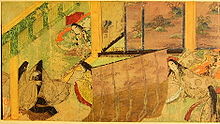- Emakimono
-
Emakimono (jap. 絵巻物), kurz Emaki (絵巻), ist eine Form von illustrierten Erzählungen, dessen Ursprünge bis zur Heian-Zeit in Japan zurückreichen. Emakimono kombiniert Text und Bilder. Es ist auf eine Handrolle gezeichnet, gemalt oder gedruckt. Man kann Emakimono zusammen mit den ägyptischen Hieroglyphen, mittelalterlichen europäischen Kirchen-Glasfenstern und einigen präkolumbischen mittelamerikanischen Manuskripten als eine frühe Form der sequentiellen Darstellung sehen.
Diese Kunstform entwickelte sich im 10. Jahrhundert und ist von kulturellen Elementen und Schriftrollen beeinflusst, die zusammen mit dem Buddhismus im 6. Jahrhundert nach Japan kamen (vgl. Buddhismus in Japan).
Ein Emakimono wird von rechts nach links gelesen, wobei die Rolle mit einer Hand entrollt und mit der anderen gleichzeitig aufgerollt wird. Auf diese Weise ist immer nur ein Ausschnitt der Geschichte zu sehen. Es wird erwartet, dass man die Rolle am Schluss wieder zurückrollt, genau wie ein Video nachdem man es gesehen hat.
Die Emakimono-Rolle wird mit einer Schnur zugebunden und einzeln oder in einer speziellen, manchmal aufwendig verzierten, Schachtel zusammen mit anderen Rollen aufbewahrt.
Das berühmteste Emaki ist eine Illustration des Genji Monogatari. Es basiert auf der um das Jahr 1000 geschriebenen Geschichte der Hofdame Murasaki Shikibu.
Weblinks
- Okada Yoshiyuki: „Emaki“. In: Encyclopedia of Shinto. der Kokugaku-in, 2. Juni 2005 (englisch)
- Kokusai Nihon Bunka Kenkyū Center: Hochaufgelöste Scans von Yōkai-Emaki
Wikimedia Foundation.

